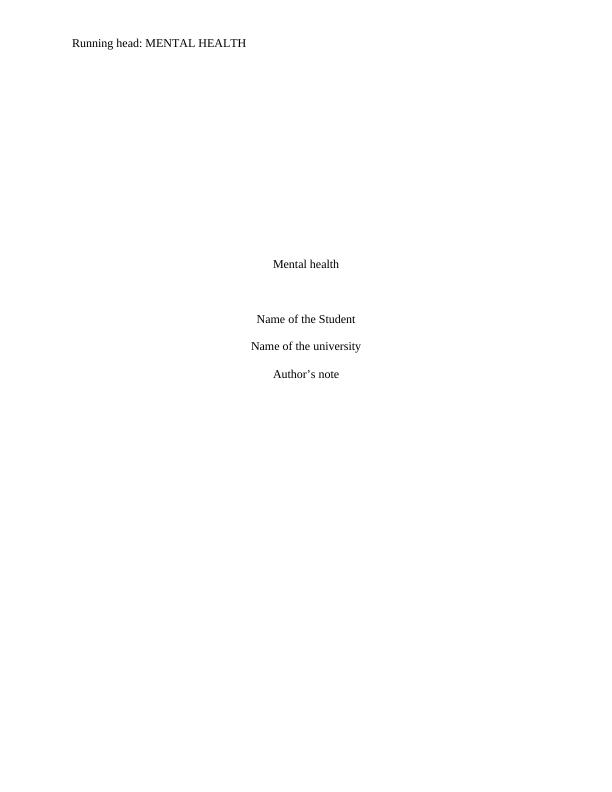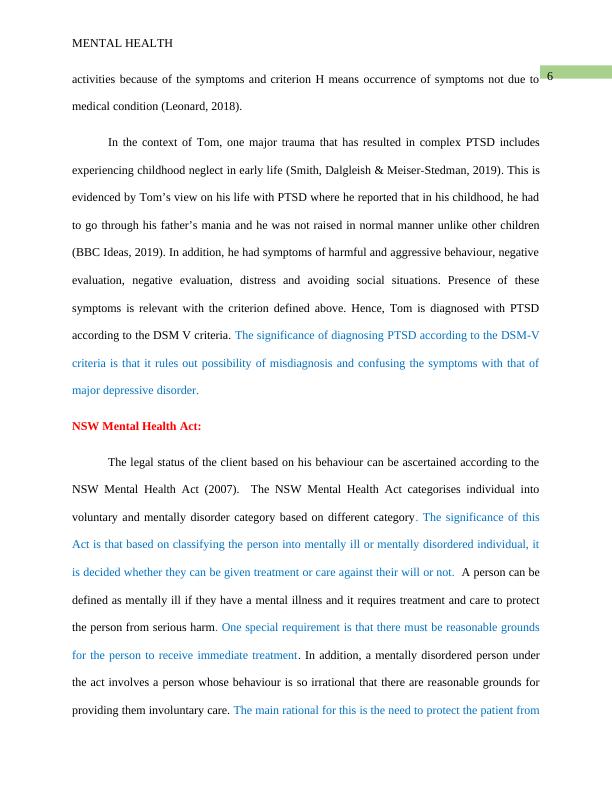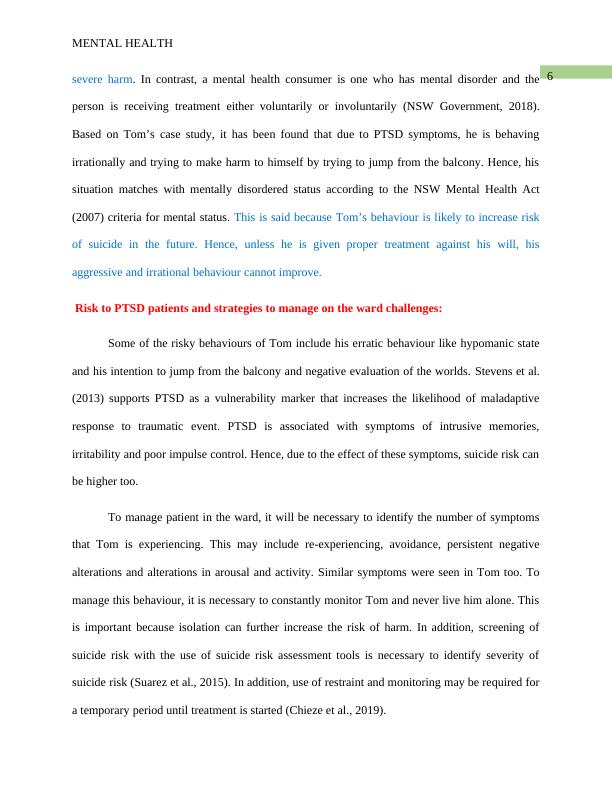Critique of the Article on Mental Health: Diagnosis, Legal Status, and Treatment Plan
Added on 2022-10-10
11 Pages3045 Words263 Views
Running head: MENTAL HEALTH
Mental health
Name of the Student
Name of the university
Author’s note
Mental health
Name of the Student
Name of the university
Author’s note

CRITIQUE OF THE ARTICLE
6
MENTAL HEALTH
Introduction:
The case study is about Tom, a 36 years old man who presented to the NSW mental
health service with symptoms of complex Post Traumatic Stress Disorder (PTSD). The current
risk that has been found is that police found Tom laughing hysterically and trying to jump from
the balcony. The main purpose of this essay is to confirm a mental health diagnosis for Tom
based on current symptoms and identify legal status of the client according to the NSW Mental
Health Act (2007). The essay will discuss about the risk associated with the behaviour, key
treatment and discharge plan for recovery of the client.
DSM-5 OR ICD-10 for PTSD symptoms for Tom
To make appropriate diagnosis of Tom according to his presenting symptoms, it is
necessary to compare his symptoms to those of the DSM-V criteria or ICD-10 for PTSD. His
symptoms have been defined as complex PTSD. The key difference between complex PTSD and
PTSD is that PTSD is mostly related to a single event, however complex PTSD is related to one
prolonged event or series of events. The traumatic episode may range from car accident to death
of loved one or sexual assault (Hyland et al., 2017). According to DSM-V criterion, there is no
separate criterion for diagnosing PTSD or complex PTSD. However, to be diagnosed with
PTSD according to the DSM-V, there is a need to meet criterion A (exposure to one of more
event), one or more symptoms from criterion B (strong and persistence distress, flashbacks,
strong bodily reaction, one symptoms from criterion C (avoidance of thoughts and people), three
symptoms from criterion D (negative evaluation of the world, negative emotional state, feeling
detached and loss of interest), three symptoms from criterion E (aggressive behaviour, poor
concentration and self-destructive behaviour) and criterion F to H. Criteria F is that all symptoms
must be present for more than one month , criterion G defines interference with daily life
6
MENTAL HEALTH
Introduction:
The case study is about Tom, a 36 years old man who presented to the NSW mental
health service with symptoms of complex Post Traumatic Stress Disorder (PTSD). The current
risk that has been found is that police found Tom laughing hysterically and trying to jump from
the balcony. The main purpose of this essay is to confirm a mental health diagnosis for Tom
based on current symptoms and identify legal status of the client according to the NSW Mental
Health Act (2007). The essay will discuss about the risk associated with the behaviour, key
treatment and discharge plan for recovery of the client.
DSM-5 OR ICD-10 for PTSD symptoms for Tom
To make appropriate diagnosis of Tom according to his presenting symptoms, it is
necessary to compare his symptoms to those of the DSM-V criteria or ICD-10 for PTSD. His
symptoms have been defined as complex PTSD. The key difference between complex PTSD and
PTSD is that PTSD is mostly related to a single event, however complex PTSD is related to one
prolonged event or series of events. The traumatic episode may range from car accident to death
of loved one or sexual assault (Hyland et al., 2017). According to DSM-V criterion, there is no
separate criterion for diagnosing PTSD or complex PTSD. However, to be diagnosed with
PTSD according to the DSM-V, there is a need to meet criterion A (exposure to one of more
event), one or more symptoms from criterion B (strong and persistence distress, flashbacks,
strong bodily reaction, one symptoms from criterion C (avoidance of thoughts and people), three
symptoms from criterion D (negative evaluation of the world, negative emotional state, feeling
detached and loss of interest), three symptoms from criterion E (aggressive behaviour, poor
concentration and self-destructive behaviour) and criterion F to H. Criteria F is that all symptoms
must be present for more than one month , criterion G defines interference with daily life

CRITIQUE OF THE ARTICLE
6
MENTAL HEALTH
activities because of the symptoms and criterion H means occurrence of symptoms not due to
medical condition (Leonard, 2018).
In the context of Tom, one major trauma that has resulted in complex PTSD includes
experiencing childhood neglect in early life (Smith, Dalgleish & Meiser‐Stedman, 2019). This is
evidenced by Tom’s view on his life with PTSD where he reported that in his childhood, he had
to go through his father’s mania and he was not raised in normal manner unlike other children
(BBC Ideas, 2019). In addition, he had symptoms of harmful and aggressive behaviour, negative
evaluation, negative evaluation, distress and avoiding social situations. Presence of these
symptoms is relevant with the criterion defined above. Hence, Tom is diagnosed with PTSD
according to the DSM V criteria. The significance of diagnosing PTSD according to the DSM-V
criteria is that it rules out possibility of misdiagnosis and confusing the symptoms with that of
major depressive disorder.
NSW Mental Health Act:
The legal status of the client based on his behaviour can be ascertained according to the
NSW Mental Health Act (2007). The NSW Mental Health Act categorises individual into
voluntary and mentally disorder category based on different category. The significance of this
Act is that based on classifying the person into mentally ill or mentally disordered individual, it
is decided whether they can be given treatment or care against their will or not. A person can be
defined as mentally ill if they have a mental illness and it requires treatment and care to protect
the person from serious harm. One special requirement is that there must be reasonable grounds
for the person to receive immediate treatment. In addition, a mentally disordered person under
the act involves a person whose behaviour is so irrational that there are reasonable grounds for
providing them involuntary care. The main rational for this is the need to protect the patient from
6
MENTAL HEALTH
activities because of the symptoms and criterion H means occurrence of symptoms not due to
medical condition (Leonard, 2018).
In the context of Tom, one major trauma that has resulted in complex PTSD includes
experiencing childhood neglect in early life (Smith, Dalgleish & Meiser‐Stedman, 2019). This is
evidenced by Tom’s view on his life with PTSD where he reported that in his childhood, he had
to go through his father’s mania and he was not raised in normal manner unlike other children
(BBC Ideas, 2019). In addition, he had symptoms of harmful and aggressive behaviour, negative
evaluation, negative evaluation, distress and avoiding social situations. Presence of these
symptoms is relevant with the criterion defined above. Hence, Tom is diagnosed with PTSD
according to the DSM V criteria. The significance of diagnosing PTSD according to the DSM-V
criteria is that it rules out possibility of misdiagnosis and confusing the symptoms with that of
major depressive disorder.
NSW Mental Health Act:
The legal status of the client based on his behaviour can be ascertained according to the
NSW Mental Health Act (2007). The NSW Mental Health Act categorises individual into
voluntary and mentally disorder category based on different category. The significance of this
Act is that based on classifying the person into mentally ill or mentally disordered individual, it
is decided whether they can be given treatment or care against their will or not. A person can be
defined as mentally ill if they have a mental illness and it requires treatment and care to protect
the person from serious harm. One special requirement is that there must be reasonable grounds
for the person to receive immediate treatment. In addition, a mentally disordered person under
the act involves a person whose behaviour is so irrational that there are reasonable grounds for
providing them involuntary care. The main rational for this is the need to protect the patient from

CRITIQUE OF THE ARTICLE
6
MENTAL HEALTH
severe harm. In contrast, a mental health consumer is one who has mental disorder and the
person is receiving treatment either voluntarily or involuntarily (NSW Government, 2018).
Based on Tom’s case study, it has been found that due to PTSD symptoms, he is behaving
irrationally and trying to make harm to himself by trying to jump from the balcony. Hence, his
situation matches with mentally disordered status according to the NSW Mental Health Act
(2007) criteria for mental status. This is said because Tom’s behaviour is likely to increase risk
of suicide in the future. Hence, unless he is given proper treatment against his will, his
aggressive and irrational behaviour cannot improve.
Risk to PTSD patients and strategies to manage on the ward challenges:
Some of the risky behaviours of Tom include his erratic behaviour like hypomanic state
and his intention to jump from the balcony and negative evaluation of the worlds. Stevens et al.
(2013) supports PTSD as a vulnerability marker that increases the likelihood of maladaptive
response to traumatic event. PTSD is associated with symptoms of intrusive memories,
irritability and poor impulse control. Hence, due to the effect of these symptoms, suicide risk can
be higher too.
To manage patient in the ward, it will be necessary to identify the number of symptoms
that Tom is experiencing. This may include re-experiencing, avoidance, persistent negative
alterations and alterations in arousal and activity. Similar symptoms were seen in Tom too. To
manage this behaviour, it is necessary to constantly monitor Tom and never live him alone. This
is important because isolation can further increase the risk of harm. In addition, screening of
suicide risk with the use of suicide risk assessment tools is necessary to identify severity of
suicide risk (Suarez et al., 2015). In addition, use of restraint and monitoring may be required for
a temporary period until treatment is started (Chieze et al., 2019).
6
MENTAL HEALTH
severe harm. In contrast, a mental health consumer is one who has mental disorder and the
person is receiving treatment either voluntarily or involuntarily (NSW Government, 2018).
Based on Tom’s case study, it has been found that due to PTSD symptoms, he is behaving
irrationally and trying to make harm to himself by trying to jump from the balcony. Hence, his
situation matches with mentally disordered status according to the NSW Mental Health Act
(2007) criteria for mental status. This is said because Tom’s behaviour is likely to increase risk
of suicide in the future. Hence, unless he is given proper treatment against his will, his
aggressive and irrational behaviour cannot improve.
Risk to PTSD patients and strategies to manage on the ward challenges:
Some of the risky behaviours of Tom include his erratic behaviour like hypomanic state
and his intention to jump from the balcony and negative evaluation of the worlds. Stevens et al.
(2013) supports PTSD as a vulnerability marker that increases the likelihood of maladaptive
response to traumatic event. PTSD is associated with symptoms of intrusive memories,
irritability and poor impulse control. Hence, due to the effect of these symptoms, suicide risk can
be higher too.
To manage patient in the ward, it will be necessary to identify the number of symptoms
that Tom is experiencing. This may include re-experiencing, avoidance, persistent negative
alterations and alterations in arousal and activity. Similar symptoms were seen in Tom too. To
manage this behaviour, it is necessary to constantly monitor Tom and never live him alone. This
is important because isolation can further increase the risk of harm. In addition, screening of
suicide risk with the use of suicide risk assessment tools is necessary to identify severity of
suicide risk (Suarez et al., 2015). In addition, use of restraint and monitoring may be required for
a temporary period until treatment is started (Chieze et al., 2019).

End of preview
Want to access all the pages? Upload your documents or become a member.
Related Documents
Comparison of Diagnostic Criterialg...
|6
|1284
|18
Diagnosis and Formulation Exercise for Mental Health Patientslg...
|8
|1800
|362
Psychiatric Diagnostic Classification Systems and Suboptimal Outcome for Patientslg...
|7
|2180
|425
Abnormal Psychology Assignment PDFlg...
|8
|2143
|68
Schizophrenia: Eric's Case Studylg...
|7
|1604
|108
Mental Health Nursing Case Study 2022lg...
|8
|2231
|34
